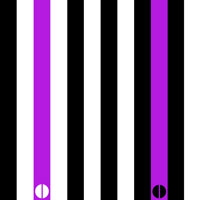zandpoortvest 10
be 2800 mechelen
t +32 15 336 336
m (b) +32 478 811 441
m (d) +32 475 477 478
Shannon Novak | April 6 - May 2, 2010
B and F Sharp negative"
Sound Fragments
click here for the Sound Fragments website
Phase 1: Local (Auckland, New Zealand), March 11 – May 2
Phase 2: National (New Zealand), March 21 – May 2
Phase 3: International, April 6 – May 2
In his latest study, Shannon Novak has sought to explore the link between colour, sound, shape, time, emotion, and social context; it is a study that examines the interrelationship between spatial form and social activity; it is a study that will both construct and make manifest a sound wave that spreads sound fragments throughout gallery spaces around the world.
“I began to feel more and more that this is what I was meant to do…to create works that through a simple combination of colour and shape, I would realize the very abstract notion of sound implied through the geometric forms I utilised. It also means I am combining, in a unique and vocational way, my two great loves – music and art.”
“My last exhibition, The Four Dimensions of a Note, launched the initial concept. This exhibition broke a musical note down into four key dimensions (pitch, loudness, duration, and the emotional state) and represented these dimensions as geometric forms on canvas.”
For Novak, the realization of this show meant the beginning of a long journey. Initially, he asked himself; how could he contribute to, or incorporate into his work the complex dialogue New Zealand abstraction presented. For example, how could he engage with, or address the dominant, and yet spartan aesthetic pioneered by the likes of Gordon Walters with which his work was so much aligned. While the similarities with Walter’s work are undeniable, Novak’s work also has much in common with the aesthetic and concerns of Michael Smither who has been interested in the relationship between music and colour for some forty years. It was the abstract sound/colour work Smithers produced that first piqued Novak’s interest. Since both artists also share a musical background, Smithers’ investigations were not only interesting to Novak but combined the same motivating aesthetics from which he could learn. It is through this rich, complex and sometimes daunting field of art history that Novak has sought to carve a niche, in terms of addressing, assimilating and yet, being distinct from, the likes of Smithers and Walters.
Further back in time Novak’s influences are at once interdisciplinary, many and varied and incorporate with art and music, the field of natural science. For example, John Denis Macdonald’s account on the relationship between sound and colour in the nineteenth century, the investigations into the relationship between sound and form by Hans Jenny, Jamie Ward’s explorations of synaesthesia and Richard Merrick’s work with harmonic science have all played a significant part. Novak has also looked at and assimilated the work of Kandinsky, Klee and of course Riley. But his deep involvement with music means that the traditions of Bach, Stravinsky, Dmitri Tymoczko and others have also contributed to a unique and natural blend which fuses both 20th century abstract painting and the aural abstraction of music. “I saw a way through the conceptual and aesthetic impasses Walters presented to me by blending music with art and this provided me with a singular direction I was very excited to be taking.”
The Work
The bars
The 12 vertical bars represent the 12 note names (or pitch) in the following order: A, Bb, B, C, C#, D, Eb, E, F, F#, G, G#
The entire work therefore represents an octave (12 semitones) with notes named for their diatonic functionality.
The colours
The colour of the bars represents the emotional state of the musician who performs the notes. The emotional state could be positive, or negative. Take the colour red for example. This could be taken as representing a positive emotion (like love) or a negative emotion (like anger). So every colour has a positive and negative possibility. The title of your work has either a 'negative' or 'positive' in it - which will tell you whether your colour represents a positive or negative emotion. I have my own interpretation of what the emotion is (e.g. love, anger, joy etc) but rather than tell you - I would rather leave this aspect of the work to your own interpretation - as everyone has different associations with different colours.
The circles
The circles represent degrees of a positive or negative emotional state as experienced by the musician when performing. The more semicircles there are vertically – the more intense the emotional state.
So putting it all together - each work represents a note, or notes played by a musician in a particular emotional state with a particular level of emotional intensity.
click here for the Sound Fragments website
